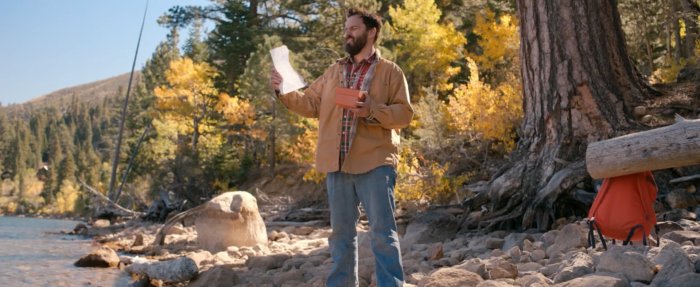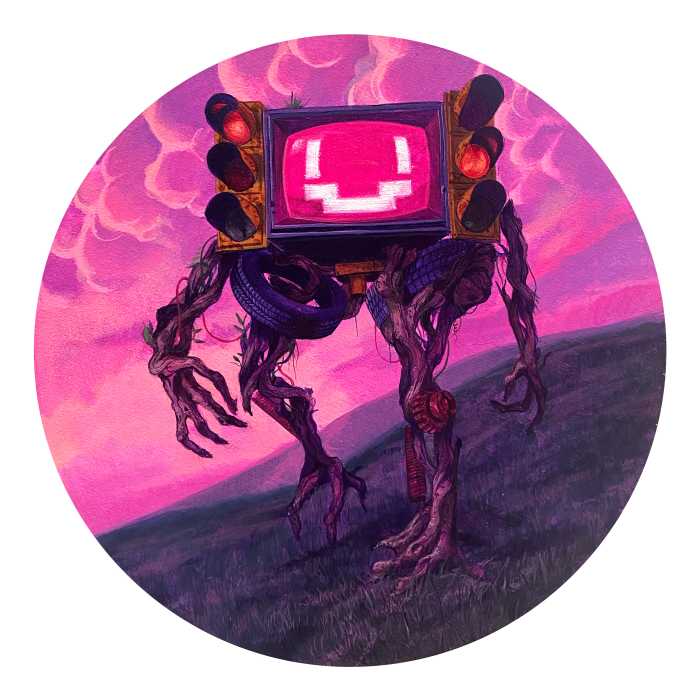When the pandemic hit and was at it’s highest, actor Jake Johnson and director/writer Trent O’Donnell decided to hit back with creativity, and the outcome is their latest comedy/drama ‘Ride the Eagle.’ The film—which follows Johnson’s Leif on a quest to complete a conditional inheritance for his mother’s cabin—was made in less than two weeks and with less than a dozen crew members. But, even with the smaller indie budget and the time constraints due to working during the pandemic, this film’s story is anything but small.
Leif never really knew his mother growing up and although the film never goes into detail, audiences find out early on that Honey (Susan Sarandon) left Leif on his own while in a cult of some sorts. It’s only after her death that they are reconnected on conditional circumstances surrounding a will, and to get a gorgeous homestead in Yosemite, Leif must complete a list of tasks left by Honey which she says are lessons he was never able to get from her in person. It’s through these tasks that Leif makes connections (some stranger than others) with a hilarious cast of characters (J.K. Simmons, D’Arcy Carden) and in turn, finds out more about what he needs to move on.
‘Ride the Eagle’ was penned and filmed entirely during the pandemic, but with the gorgeous backdrop of Yosemite, which plays a role in the film as much as the actors. With a heartwarming and smartly funny look at grief, it feels relevant no matter what time we live in.
Johnson sat down to discuss more on what went into making ‘Ride the Eagle.’

Where did the idea for this story come from?
It started because this was pre-vaccine in Los Angeles and it was really in the middle of the worst of the pandemic. I didn’t know how I was going to get back to work again and I didn’t know how Hollywood was going to start making projects. So, Trent O’Donnell, the co-writer and director and I, we wanted to try and experiment and make a movie and see if there was a way back in. Because if Hollywood wasn’t able to open through the unions and with safety and COVID, I needed to keep making stuff. So, the origins were, can we tell a story with the construct of a world where it feels like a movie that we still care about? We had to figure out what was available and where we could shoot, and we built it from that.
What can you tell me about your character?
I would describe Leif as a guy who’s very closed off emotionally. He thinks he’s fine and he thinks everything is going great because professionally he’s doing fine. The death of his mother kind of shakes him to his core and makes him realize that he has some regrets and he should start opening up sooner than later because life is going fast.
You’ve worked with Trent before on other projects. How did that working relationship benefit with this film?
With Trent, we had done about 70 episodes of ‘New Girl’ together and we really know one another. We know each other’s comedy and we know each other as people and we know each other’s families. So, we didn’t have a lot of time on this movie, we shot this movie in 10 days and all the work was done in prep. We weren’t really improvising and everything was written pretty intensely. With our crew, we only had 7 people up in the mountains, so everybody needed to be doing everything really fast.
Trent and I didn’t have time to figure out how we liked making movies or how we liked to work, and what was nice about this is that we already knew it, so it felt like a very old relationship doing a new project. I don’t think it would be possible with me with a new director because he and I are not sensitive with each other at all, so we can say very quickly what we needed to have happen. I didn’t need to worry about offending the other person’s ego if that makes sense. There was just so much logistical stuff that we had to do that Trent and I needed to be 100% on the same page. And we were, and he’s just kind of the best guy and an incredible director and just the easiest person to work with.

How is the experience working on a small indie film like this compare to say, a huge network show with lots of bells and whistles?
With the bells and whistles, the entire trick with acting is how do you cut that out so that you can forget about it. The audience doesn’t care how many people are on the other side of the camera staring at you, they just want to see the performance… so I do feel like a big trick of the business is how you’re able to shut all of that off.
The beauty of an Indie is, there’s nothing to shut off, no one’s there. It would be Trent, the camera operator, the assistant and myself on the side of the mountain. But [on the other hand] there’s a reason why you have a big crew and it’s because everyone is so talented. So, we really missed all of that talent on this. But the only real difference for this for an actor is, you need to shut all of that off when you were shooting… with this, there was nothing to shut off.
What role did the location play into the story?
Part of this for us was we were stuck inside our house and we missed seeing nature, we missed seeing the world and that was something that I really missed watching. Any kind of entertainment I was watching had everyone wearing masks and [they] were inside and everything was really controlled and contained. I was like man, I really miss a travel show, I missed seeing like Anthony Bourdain in Thailand. I wanted to see the world and I don’t want to see it through the news and how empty everything is and how terrible it is.
So part of this, we just wanted to show that yes, we’re in a terrible moment but mountains are still beautiful and they’re still right here when we figure this out. We wanted to show a beautiful part of the country—and say what you will about America, but America is gorgeous. With all of our back and forth we were like California is great and America is great, and we wanted to make something that felt good and celebrated coming together. That was kind of the main key.

This film explores grief as well as self-exploration but it also makes you laugh at moments. Why was the comedy an important part to keep in a heavy story?
I know for us, we didn’t want to be stuck to one tone. When Trent and I started coming up with this story we wanted to make this movie about Leif having to earn this cabin and Leif having to get over this. But I don’t want to make a movie that doesn’t have any laughs in it. Selfishly, I like to crack jokes at work and have fun and do things that people find funny and that I find funny. So, to us, that makes it really important. Even in the sad moments we try to throw in some laughs and bits in there, because I wasn’t interested in trying to make it a really dramatic set. There is grief and there are layers to this movie, but we try not to take the movie too seriously. It is a sad movie but we want some laughs and we want it to feel good as opposed to feeling terrible.
DECAL will release ‘Ride the Eagle’ in theaters, On Demand and digital on July 30.
































